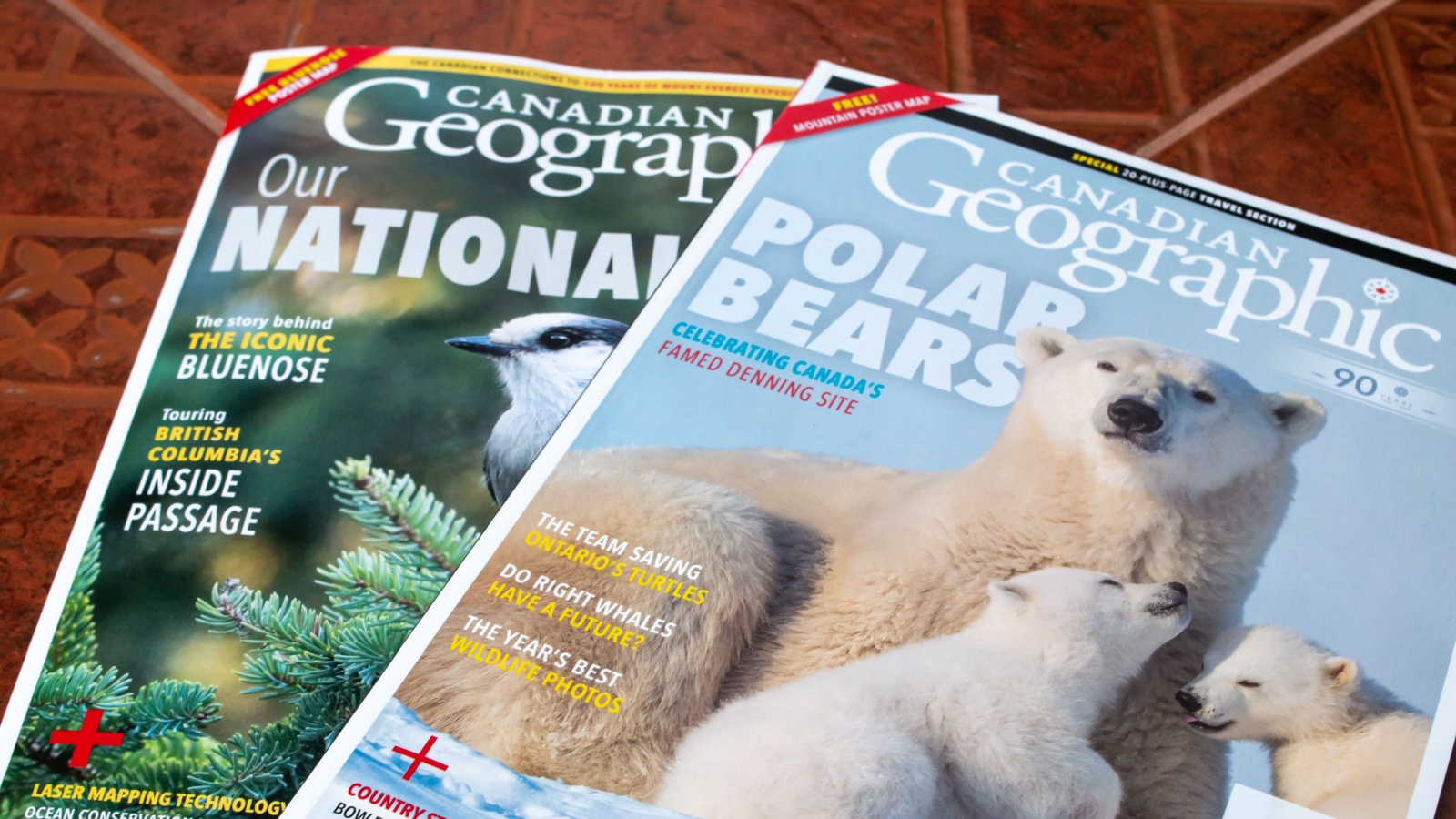Canada’s magazine industry once thrived with a vibrant mix of fashion, culture, lifestyle, and news publications that reflected the country’s creative spirit and diverse identity. From glossy fashion titles to thought-provoking cultural journals, these magazines shaped national conversations and gave voice to Canadian talent. Yet, as advertising declined and readers moved online, many iconic titles struggled to survive in print. Here are 24 Canadian magazines that don’t exist anymore.
Flare

Flare was one of Canada’s most recognized fashion and lifestyle magazines, founded in 1979 by Maclean Hunter. It focused on Canadian designers, pop culture, and women’s issues, offering a uniquely national perspective in a market dominated by American titles. Over the decades, it launched the careers of many Canadian models and writers. However, print readership declined sharply in the 2010s, and Rogers Media transitioned Flare to digital-only in 2017. In 2023, it was folded into Chatelaine’s online platform, officially ending its independent identity. Flare’s closure marked the loss of a cornerstone in Canadian fashion journalism.
Chatelaine (Print Edition)

Chatelaine was first published in 1928 and became Canada’s most iconic women’s magazine. It covered everything from health and recipes to politics and personal stories, reflecting the evolution of Canadian society over nearly a century. Known for its progressive editorial voice, Chatelaine influenced generations of readers. However, declining print advertising and rising digital consumption led Rogers Sports & Media to end the magazine’s regular print edition in 2023. The publication continues digitally, but its print closure marked the end of one of Canada’s most enduring and culturally significant magazine formats.
Maclean’s (Weekly Print Edition)

Maclean’s, founded in 1905, was Canada’s leading news magazine and a trusted national voice for politics, current affairs, and culture. For decades, its weekly print edition was essential reading across the country. However, like many publications, Maclean’s faced reduced circulation and advertising as readers moved online. In 2016, the magazine shifted from weekly to monthly print publication, and later largely transitioned to digital formats. Although it still exists online, the end of its weekly print run symbolized a major turning point for Canadian print journalism and long-form political reporting.
Canadian Home Journal

Canadian Home Journal was a popular women’s and family magazine that began publication in 1905. It featured articles on homemaking, child care, fashion, and domestic culture, appealing to middle-class Canadian households for decades. Published by Maclean Publishing, it became one of the country’s most widely circulated magazines in the early to mid-20th century. However, with changing reader interests and competition from television and newer lifestyle magazines, it ceased publication in 1958. Its disappearance reflected the shifting postwar media landscape and the decline of traditional domestic-focused periodicals in Canada.
Saturday Night Magazine

Saturday Night Magazine, founded in 1887, was one of Canada’s oldest and most respected general-interest publications. It covered politics, literature, and national culture, featuring contributions from leading Canadian writers. The magazine earned a reputation for intellectual journalism and deep commentary on Canadian identity. Despite its strong legacy, financial pressures and declining readership led to its closure in 2005 after several ownership and format changes. Its loss was widely seen as a blow to Canadian cultural journalism, ending over a century of thoughtful editorial influence.
Homemakers

Homemakers was launched in 1966 as a magazine focused on women’s lifestyle, food, and family topics, catering to modern Canadian households. It combined practical advice with social awareness, often highlighting issues like health, education, and women’s empowerment. Owned by Transcontinental Media, Homemakers enjoyed a loyal readership for decades but faced the same digital disruption that affected most print magazines. In 2011, the publication ceased both its print and digital operations. Its closure marked the end of one of Canada’s most enduring and socially conscious lifestyle magazines.
Canadian Geographic (Print Monthly Edition)

Canadian Geographic, founded in 1930 by the Royal Canadian Geographical Society, was celebrated for its photography, environmental reporting, and exploration features. It inspired readers with stories of Canada’s landscapes and scientific achievements. While the organization continues to produce special print issues and digital editions, the traditional monthly print cycle was discontinued in the late 2010s. Rising costs and changing reader habits led to the move toward a reduced publishing schedule. The end of its monthly print run marked a significant shift for one of Canada’s most visually iconic magazines.
Fashion Magazine (Print Edition)

Fashion Magazine, established in 1977, was Canada’s premier publication for high-end style, beauty, and culture. Based in Toronto, it provided a platform for Canadian designers and creative professionals while covering global fashion trends. Over time, it became an essential part of the country’s fashion industry. However, declining print advertising and rising digital engagement pushed its publisher, St. Joseph Communications, to discontinue the regular print edition in 2023. The magazine continues online, but the end of its print format signified the broader transformation of Canada’s fashion media landscape.
MoneySense (Print Edition)

MoneySense began in 1999 as a personal finance magazine under Rogers Publishing. It offered practical advice on investing, retirement, taxes, and smart money management for Canadians. Known for its accessible tone and data-driven features, it quickly became one of Canada’s most trusted financial publications. However, as audiences turned to digital platforms for financial news and calculators, print revenues declined. In 2016, Rogers ended its print edition and moved MoneySense entirely online. Though the digital version remains active, the end of the print edition marked the decline of financial lifestyle magazines in Canada.
Toronto Life Fashion

Toronto Life Fashion was a spinoff of the main Toronto Life magazine, launched in the early 2000s to cover seasonal trends, local designers, and Canada’s growing fashion scene. It featured glossy photography, style guides, and event coverage from Toronto Fashion Week. Despite strong editorial quality, it faced limited advertising support and overlapping readership with its parent publication. By the late 2000s, Toronto Life folded the title back into its main magazine to streamline operations. The short-lived publication reflected the challenge of sustaining niche print titles in a shifting media economy.
Elm Street

Elm Street was a Canadian lifestyle and culture magazine launched in 1997 by Telemedia. It focused on intelligent writing for women, blending features on politics, arts, and personal essays with style and wellness content. Despite critical acclaim and a loyal readership, it struggled financially against larger competitors and declining ad revenue. In 2004, St. Joseph Media discontinued the magazine after acquiring Telemedia’s assets. Elm Street’s closure was widely lamented in Canadian media circles for ending one of the country’s few magazines balancing intellect, creativity, and accessibility for women readers.
Shift Magazine

Shift Magazine began in 1992 in Toronto as a technology and digital culture publication. Initially focused on the creative potential of new media, it gained recognition for its coverage of internet trends, innovation, and modern art. The magazine anticipated the rise of tech journalism in Canada and attracted a younger, progressive audience. However, financial instability and competition from online outlets led to its closure in 2003. Despite its short run, Shift played a key role in introducing Canadian readers to early digital culture and the impact of emerging technologies.
The Beaver (Original Edition)

The Beaver was founded in 1920 by the Hudson’s Bay Company as a history magazine documenting Canada’s northern development, exploration, and trade. It evolved into one of the country’s most respected historical publications. However, in 2010, the magazine rebranded as Canada’s History to modernize its image and avoid confusion with unrelated internet terminology. The Beaver name was officially retired, marking the end of a 90-year legacy under its original title. While its content continues, the end of The Beaver brand symbolized a shift in how Canadian heritage publications connect with modern readers.
Explore Magazine (Print Edition)

Explore Magazine launched in 1981 as a publication dedicated to outdoor adventure, travel, and environmental awareness in Canada. It featured stories about hiking, kayaking, and wilderness exploration across the country. Although highly regarded for its photography and authentic storytelling, print readership declined steadily in the digital era. By the late 2010s, Explore reduced and eventually phased out regular print publication, focusing instead on digital subscriptions and online community content. Its transition reflected how Canadian niche magazines adapted to survive within the evolving outdoor and adventure media market.
Gardening Life

Gardening Life debuted in the mid-1990s under the direction of Canadian gardening expert Trevor Cole. The magazine catered to home gardeners, landscapers, and nature enthusiasts, offering practical advice and seasonal inspiration. It was beautifully designed, combining stunning photography with expert tips for Canadian climates. Despite a loyal readership, the publication ceased in 2008 due to declining advertising revenue and industry-wide print reductions. Its closure left a notable gap in Canada’s gardening media landscape and marked the end of one of the country’s most admired home and garden magazines.
Canadian Family

Canadian Family was a lifestyle magazine launched in 1997, aimed at parents seeking advice on child care, education, and family-friendly living. Known for its inclusive approach and relatable content, it appealed to modern Canadian households balancing work and parenting. Published by St. Joseph Communications, it maintained a strong reputation for practical and trustworthy guidance. However, falling print advertising and the shift to online parenting content led to its discontinuation in 2014. Though fondly remembered, its closure reflected the growing dominance of digital media over traditional family-oriented print publications in Canada.
Wish Magazine

Wish Magazine was launched in 2004 by St. Joseph Communications as a lifestyle publication for Canadian women. It covered fashion, food, travel, and home décor with an upscale, approachable tone. The magazine gained popularity for its elegant design and practical style advice but faced stiff competition from established titles like Flare and Chatelaine. Declining print advertising revenue forced its closure in 2009 after only five years in circulation. Despite its brief lifespan, Wish was praised for its quality content and is remembered as one of Canada’s most stylish short-lived lifestyle magazines.
Glow Magazine

Glow Magazine was introduced in 2002 as a beauty and wellness publication produced by Rogers Media in partnership with Shoppers Drug Mart. It featured skincare, health, and lifestyle articles aimed at Canadian women, combining editorial integrity with brand collaboration. The bilingual publication (Glow in English and Pure in French) was distributed nationally through Shoppers locations. By 2017, Rogers ended both editions as part of its exit from consumer magazines. Glow’s closure reflected how branded print partnerships struggled to remain viable in the face of online beauty influencers and digital advertising.
Western Living (Print Monthly Edition)

Western Living, founded in 1970 in Vancouver, became one of Western Canada’s leading design and lifestyle magazines. It focused on architecture, interior design, travel, and food, highlighting the West Coast’s creative and cultural identity. Although the brand continues in a digital and limited print format, the traditional monthly print schedule ended in the early 2020s due to cost constraints and changing reader preferences. The reduction marked a turning point for regional lifestyle media in Canada, showing how even strong niche titles adapted to a smaller print presence in favor of digital expansion.
Canadian Business (Print Edition)

Canadian Business, established in 1928, was one of the country’s oldest business publications, offering in-depth reporting on finance, entrepreneurship, and economics. It became a go-to source for business leaders and investors for decades. However, the shift toward instant online financial news reduced demand for printed analysis. Rogers Media discontinued the print edition in 2016, moving the brand fully online under the Maclean’s group. Although it continues digitally, the closure of its print magazine ended nearly 90 years of publication, marking a major loss in Canada’s business journalism landscape.
The Idler

The Idler was an influential Canadian literary and arts magazine founded in 1985 by Dan Wells. Known for publishing contemporary fiction, essays, and cultural commentary, it provided a platform for emerging writers and thinkers. Despite critical success, the magazine struggled financially and relied heavily on grants and subscriptions. After a decade of publication, it ceased in 1993 due to funding shortages. The Idler remains an important part of Canada’s independent literary history, remembered for its intellectual tone and support for Canadian voices outside mainstream publishing.
Vancouver Magazine (Print Edition)

Vancouver Magazine, first published in 1967, became the city’s leading lifestyle and urban culture publication. It covered local politics, dining, design, and social issues with sharp writing and a strong visual identity. The magazine maintained influence for decades but faced the same financial pressures as other regional publications. In 2023, the regular monthly print edition was discontinued, with content moving primarily online. While Vancouver Magazine remains active digitally, the end of its print format marked another significant step in the West Coast media industry’s shift toward digital-only journalism.
Urban Male Magazine (UMM)

Urban Male Magazine (UMM) debuted in 1998 as a lifestyle and entertainment magazine for Canadian men. It featured articles on fashion, cars, sports, and pop culture, targeting a younger demographic similar to Maxim and GQ. Known for its edgy tone and celebrity covers, UMM became a recognizable name in men’s publishing. However, falling ad revenue and changing audience interests led to its closure in 2014. The brand’s end reflected how men’s lifestyle magazines struggled to compete with digital media and evolving definitions of masculinity in the 2010s.
Toro Magazine

Toro Magazine was launched in 2002 as a high-end Canadian men’s magazine focused on culture, politics, and lifestyle. It distinguished itself from flashier competitors by featuring quality journalism, photography, and long-form interviews. Despite critical praise, the print edition folded in 2007 due to declining advertising revenue. An online version launched in 2008 but ceased operations by 2013. Toro’s closure marked the end of one of Canada’s most ambitious independent magazine ventures, remembered for its sophistication and attempt to redefine men’s media in a changing publishing environment.
21 Products Canadians Should Stockpile Before Tariffs Hit

If trade tensions escalate between Canada and the U.S., everyday essentials can suddenly disappear or skyrocket in price. Products like pantry basics and tech must-haves that depend on are deeply tied to cross-border supply chains and are likely to face various kinds of disruptions
21 Products Canadians Should Stockpile Before Tariffs Hit
